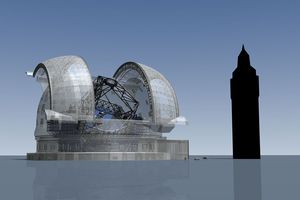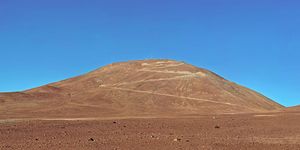The Telescope
The European Extremely Large Telescope (E-ELT) will be the largest optical and infra-red telescope ever built. Scientists and engineers from all over Europe are working on plans for a telescope with a mirror that is over 39 metres in diameter. The area of this mirror is larger than the combined reflecting area of all the major research telescopes currently in existence. This increased area effectively allows us to probe to much larger distances in the Universe (e.g. to detect the light from the first galaxies that formed in the Universe) as well as to study celestial objects with unrivalled spatial resolution (e.g. to directly image extra-solar planets).
The picture top right shows a rendition of the current design of the E-ELT and its enclosing structure or dome. Here, it is shown with resepect to London's Big Ben and the dots next to the telescope are cars. You can see the overall structure will be huge, it will be about the same size as a football stadium!
The telescope will be built by the European Southern Observatory (ESO) who also built the Very Large Telescopes, some of the biggest telescopes on Earth at the moment. The E-ELT is currently being designed, and it should be ready to make observations in ten years from now. On 26 April 2010, the ESO Council selected Cerro Armazones as the site for the E-ELT. Cerro Armazones is a 3,000 metre high mountain in the central part of Chile’s Atacama Desert, an area that is already home to some of the world's largest telescopes.
Some of the most important and complicated parts of a telescope are the instruments that take the light that is collected by the mirror and transform this into images and spectra that can be then recorded and analysed. Currently eight concepts for cameras and spectrographs are being studied in Europe, astronomers and engineers in the UK are involved in six of these projects, of which three have major UK inolvement or leadership.
To find out more about the E-ELT, the people who work with it, and the big questions about the universe that we hope to solve, follow the links below.
| < Home | The Telescope |
> Technology | >> Science |
There is more information on the E-ELT at the ESO website.




